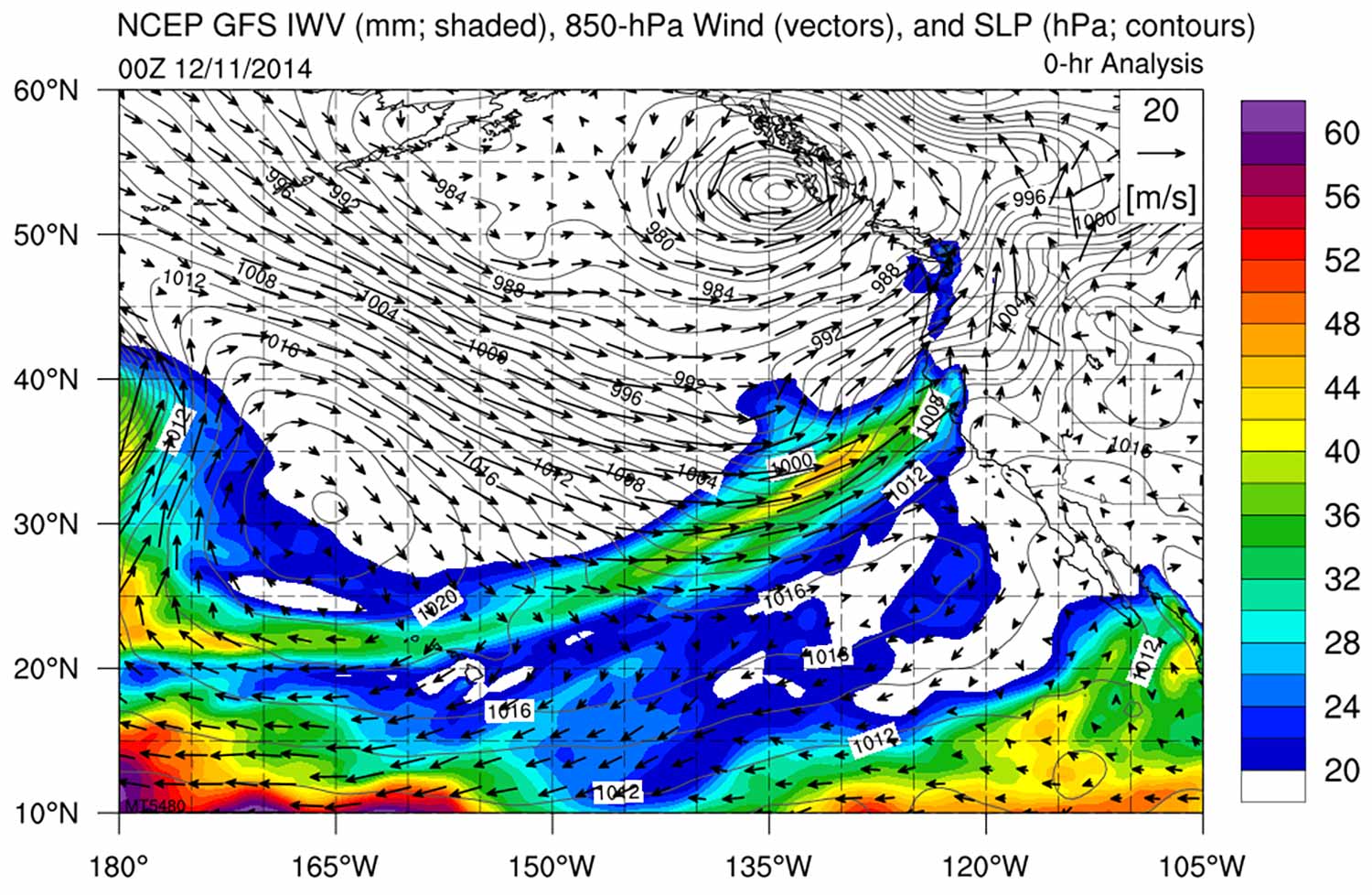Governor Signs Legislation to Improve Understanding of Atmospheric Rivers
Supports more effective management of water resources during extreme weather episodes
By:
- Robert Monroe
Media Contact:
- Mario Aguilera - maguilera@ucsd.edu
- Robert Monroe - scrippsnews@ucsd.edu
Published Date
By:
- Robert Monroe
Share This:
Article Content

Map of water vapor carried by an atmospheric river toward the West Coast in December 2014. Data from NCEP Global Forecast System
California Gov. Jerry Brown signed into law Oct. 9 legislation that will improve the state’s ability to respond to major precipitation episodes with an aim to better manage water supply by expanding climate and weather research focused on the causes of drought and flood led by Scripps Institution of Oceanography, University of California San Diego.
The legislation requires the Department of Water Resources (DWR) to improve flood protection and water reliability by gaining more knowledge of atmospheric rivers (ARs) that supply 30 to 50 percent of California’s precipitation and water supply (typically in six to eight events per winter), and are largely responsible for the high year-to-year variability of California precipitation. This variability is double or triple the variability in the rest of the U.S. and presents unique challenges for California water supply and flood control.
“We are grateful to the governor and our legislators for taking tangible action to address critical water supply issues, especially at a time when our state is faced with drought and floods,” said Chancellor Pradeep K. Khosla. “As a leader in ocean, earth and atmospheric science, UC San Diego’s Scripps Institution of Oceanography will be able to advance our research and policy because of this legislation, which will ultimately benefit our community, state and world.”
The governor approved Senate Bill 758, which was authored by 39th District State Senator Marty Block, received broad support from California’s legislative leadership including Senate Pro Tem Kevin de Leon and Assembly Speaker Toni Atkins.
“Given California’s current drought, it is critical that the state have accurate science to predict precipitation patterns and make intelligent water management decisions,” said Block. “SB 758 will assist us in ensuring good stewardship of a valuable resource.”
Atmospheric rivers are narrow regions, about 200 miles wide, in the atmosphere that are responsible for most of the movement of water vapor outside the tropics and when one hits California can produce heavy rain and snow. A strong AR can move an amount of water vapor equivalent to about 20 times the average flow of liquid water at the mouth of the Mississippi River.
Weather and climate scientist Marty Ralph, who leads the Center for Western Weather and Water Extremes (CW3E) at Scripps, which studies atmospheric rivers, said “It will bring needed emphasis, tailored to California’s unique needs, on observing and predicting ARs, on understanding how changes in climate can affect future California drought and flood risks, and developing new tools to support water management and enhanced hydropower availability.”
“It is important to acknowledge that earlier support from DWR in particular, and from NOAA and others, has provided the scientific foundation for this effort, including creation of a special state-wide AR monitoring system,” Ralph added.
SB 758 creates the Atmospheric Rivers: Research, Mitigation, and Climate Forecasting Program which would require the DWR to study the causes of atmospheric rivers and their impact on extreme weather conditions. It would also require DWR to operate reservoirs in a manner that improves flood protection and captures water produced by atmospheric rivers. This scientific forecasting can also be shared with the federal government to assist with better-informed and coordinated water management.
Block’s legislation would build on a pilot project to test Forecast-Informed Reservoir Operations (FIRO) on Lake Mendocino, a vital reservoir on the Russian River. FIRO is a water management strategy that uses weather forecasts to help inform decisions on when water should be released or retained depending on forecasts and current watershed conditions. CW3E and the Sonoma County Water Agency (SCWA) lead the project.
“FIRO and the science of atmospheric rivers that supports it have the potential to transform water management and increasing the reservoir’s water supply by 10-25 percent to support urban and agriculture uses in addition to improving environmental conditions in many dry years,” said SCWA Chief Engineer Jay Jasperse. “It can help restore endangered salmon populations, and potentially reduce flood risk. On a longer time scale, this holds great promise for supporting climate adaptation, and could reduce carbon emissions by increasing hydropower availability.”
The legislation was supported by the San Diego County Water Authority, Bay Area Flood Protection Agencies Association, the Orange County Water District, the Santa Clara Valley Water District, and the Sonoma County Water Agency.
Share This:
You May Also Like
Stay in the Know
Keep up with all the latest from UC San Diego. Subscribe to the newsletter today.



